for dark bags, try going to like CVS and buy the L’oreal bags cream. it totally works!
Ok first of all, dark circles can be hereditary so to try and prevent them drink lots of water, eat healthy and get plenty of sleep. If you don’t want to wear makeup try a tinted moisturizer and a blush, that will make your skin have more color!!.One of my friends was tired & pale all the time. Her doctor found that she was anemic, She started getting shots of vitamin B12, and her whole face brightened up about 2 days later, u could really see a difference!!!Vitamin B-12, or Cobalamin, is the largest and most complex vitamin currently known to man. A slight deficiency of vitamin B-12 can lead to anemia, fatigue, mania, and depression, while a long term deficiency can potentially cause permanent damage to the brain and central nervous system. Vitamin B-12 can only be manufactured by bacteria and can only be found naturally in animal products, however, synthetic forms are widely available and added to many foods like cereals. Vitamin B-12 can be consumed in large doses because excess is excreted by the body or stored in the liver for use when supplies are scarce. Stores of B-12 can last for up to a year. Below is a list of the top ten vitamin b12 rich foods. Click here for other foods high in Clams, Oysters, and Mussels
moisturizer and a blush, that will make your skin have more color!!.One of my friends was tired & pale all the time. Her doctor found that she was anemic, She started getting shots of vitamin B12, and her whole face brightened up about 2 days later, u could really see a difference!!!Vitamin B-12, or Cobalamin, is the largest and most complex vitamin currently known to man. A slight deficiency of vitamin B-12 can lead to anemia, fatigue, mania, and depression, while a long term deficiency can potentially cause permanent damage to the brain and central nervous system. Vitamin B-12 can only be manufactured by bacteria and can only be found naturally in animal products, however, synthetic forms are widely available and added to many foods like cereals. Vitamin B-12 can be consumed in large doses because excess is excreted by the body or stored in the liver for use when supplies are scarce. Stores of B-12 can last for up to a year. Below is a list of the top ten vitamin b12 rich foods. Click here for other foods high in Clams, Oysters, and Mussels
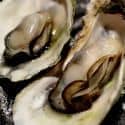 Shellfish are a great source of vitamin B12 and can be eaten raw, baked, steamed, fried, or made into chowder. In addition to vitamin B12 shellfish are a good source of zinc, copper, and iron. Clams provide the most vitamin B-12 with 98.9μg per 100g serving, accounting for 1648% of the DV. That is 84μg (1401% DV) per 3 ounce serving, and 187.9μg (3132% DV) in 20 small clams, or 9.4μg (156.6 %DV) in one small clam. Mussels and oysters are also good sources of B12 providing 600% DV and 400% DV per 100 gram serving. Click to see complete nutrition facts.
Shellfish are a great source of vitamin B12 and can be eaten raw, baked, steamed, fried, or made into chowder. In addition to vitamin B12 shellfish are a good source of zinc, copper, and iron. Clams provide the most vitamin B-12 with 98.9μg per 100g serving, accounting for 1648% of the DV. That is 84μg (1401% DV) per 3 ounce serving, and 187.9μg (3132% DV) in 20 small clams, or 9.4μg (156.6 %DV) in one small clam. Mussels and oysters are also good sources of B12 providing 600% DV and 400% DV per 100 gram serving. Click to see complete nutrition facts.
 for your bags, sleep on two pillows, and on your side or back, not your belly.
for your bags, sleep on two pillows, and on your side or back, not your belly.
Ok first of all, dark circles can be hereditary so to try and prevent them drink lots of water, eat healthy and get plenty of sleep. If you don’t want to wear makeup try a tinted
 moisturizer and a blush, that will make your skin have more color!!.One of my friends was tired & pale all the time. Her doctor found that she was anemic, She started getting shots of vitamin B12, and her whole face brightened up about 2 days later, u could really see a difference!!!Vitamin B-12, or Cobalamin, is the largest and most complex vitamin currently known to man. A slight deficiency of vitamin B-12 can lead to anemia, fatigue, mania, and depression, while a long term deficiency can potentially cause permanent damage to the brain and central nervous system. Vitamin B-12 can only be manufactured by bacteria and can only be found naturally in animal products, however, synthetic forms are widely available and added to many foods like cereals. Vitamin B-12 can be consumed in large doses because excess is excreted by the body or stored in the liver for use when supplies are scarce. Stores of B-12 can last for up to a year. Below is a list of the top ten vitamin b12 rich foods. Click here for other foods high in Clams, Oysters, and Mussels
moisturizer and a blush, that will make your skin have more color!!.One of my friends was tired & pale all the time. Her doctor found that she was anemic, She started getting shots of vitamin B12, and her whole face brightened up about 2 days later, u could really see a difference!!!Vitamin B-12, or Cobalamin, is the largest and most complex vitamin currently known to man. A slight deficiency of vitamin B-12 can lead to anemia, fatigue, mania, and depression, while a long term deficiency can potentially cause permanent damage to the brain and central nervous system. Vitamin B-12 can only be manufactured by bacteria and can only be found naturally in animal products, however, synthetic forms are widely available and added to many foods like cereals. Vitamin B-12 can be consumed in large doses because excess is excreted by the body or stored in the liver for use when supplies are scarce. Stores of B-12 can last for up to a year. Below is a list of the top ten vitamin b12 rich foods. Click here for other foods high in Clams, Oysters, and Mussels
 Shellfish are a great source of vitamin B12 and can be eaten raw, baked, steamed, fried, or made into chowder. In addition to vitamin B12 shellfish are a good source of zinc, copper, and iron. Clams provide the most vitamin B-12 with 98.9μg per 100g serving, accounting for 1648% of the DV. That is 84μg (1401% DV) per 3 ounce serving, and 187.9μg (3132% DV) in 20 small clams, or 9.4μg (156.6 %DV) in one small clam. Mussels and oysters are also good sources of B12 providing 600% DV and 400% DV per 100 gram serving. Click to see complete nutrition facts.
Shellfish are a great source of vitamin B12 and can be eaten raw, baked, steamed, fried, or made into chowder. In addition to vitamin B12 shellfish are a good source of zinc, copper, and iron. Clams provide the most vitamin B-12 with 98.9μg per 100g serving, accounting for 1648% of the DV. That is 84μg (1401% DV) per 3 ounce serving, and 187.9μg (3132% DV) in 20 small clams, or 9.4μg (156.6 %DV) in one small clam. Mussels and oysters are also good sources of B12 providing 600% DV and 400% DV per 100 gram serving. Click to see complete nutrition facts.#2: Liver 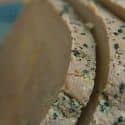 Often appearing on the culinary scene as pâté, liver can also be prepared steamed or fried with onions and herbs. The liver of most any animal is packed with vitamin B-12, the highest on the list are: Lamb, beef, veal, moose, turkey, duck, and goose respectively. Lamb liver provides 85.7μg (1428% DV) of vitamin B12 per 100g serving, or 72.85μg (230% DV) in a 3 ounce serving. Click to see complete nutrition facts.
Often appearing on the culinary scene as pâté, liver can also be prepared steamed or fried with onions and herbs. The liver of most any animal is packed with vitamin B-12, the highest on the list are: Lamb, beef, veal, moose, turkey, duck, and goose respectively. Lamb liver provides 85.7μg (1428% DV) of vitamin B12 per 100g serving, or 72.85μg (230% DV) in a 3 ounce serving. Click to see complete nutrition facts.
 Often appearing on the culinary scene as pâté, liver can also be prepared steamed or fried with onions and herbs. The liver of most any animal is packed with vitamin B-12, the highest on the list are: Lamb, beef, veal, moose, turkey, duck, and goose respectively. Lamb liver provides 85.7μg (1428% DV) of vitamin B12 per 100g serving, or 72.85μg (230% DV) in a 3 ounce serving. Click to see complete nutrition facts.
Often appearing on the culinary scene as pâté, liver can also be prepared steamed or fried with onions and herbs. The liver of most any animal is packed with vitamin B-12, the highest on the list are: Lamb, beef, veal, moose, turkey, duck, and goose respectively. Lamb liver provides 85.7μg (1428% DV) of vitamin B12 per 100g serving, or 72.85μg (230% DV) in a 3 ounce serving. Click to see complete nutrition facts.#3: Caviar (Fish Eggs)  Caviar and fish eggs are most often eaten as a garnish or spread. The eggs of whitefish contain the most vitamin B-12 with 56.4μg (940% DV) per 100g serving. Caviar contains a third of that with 20μg (333% DV) of vitamin B12 per 100g serving, 5.6μg (93% DV) per ounce, and 3.2μg (53% DV) per tablespoon. Chicken eggs, by comparison, only offer 1.29μg (22% DV) of vitamin B-12 per 100g serving, or 0.65μg (11% DV) per egg. Click to see complete nutrition facts. Buy Caviar from Amazon.com
Caviar and fish eggs are most often eaten as a garnish or spread. The eggs of whitefish contain the most vitamin B-12 with 56.4μg (940% DV) per 100g serving. Caviar contains a third of that with 20μg (333% DV) of vitamin B12 per 100g serving, 5.6μg (93% DV) per ounce, and 3.2μg (53% DV) per tablespoon. Chicken eggs, by comparison, only offer 1.29μg (22% DV) of vitamin B-12 per 100g serving, or 0.65μg (11% DV) per egg. Click to see complete nutrition facts. Buy Caviar from Amazon.com
 Caviar and fish eggs are most often eaten as a garnish or spread. The eggs of whitefish contain the most vitamin B-12 with 56.4μg (940% DV) per 100g serving. Caviar contains a third of that with 20μg (333% DV) of vitamin B12 per 100g serving, 5.6μg (93% DV) per ounce, and 3.2μg (53% DV) per tablespoon. Chicken eggs, by comparison, only offer 1.29μg (22% DV) of vitamin B-12 per 100g serving, or 0.65μg (11% DV) per egg. Click to see complete nutrition facts. Buy Caviar from Amazon.com
Caviar and fish eggs are most often eaten as a garnish or spread. The eggs of whitefish contain the most vitamin B-12 with 56.4μg (940% DV) per 100g serving. Caviar contains a third of that with 20μg (333% DV) of vitamin B12 per 100g serving, 5.6μg (93% DV) per ounce, and 3.2μg (53% DV) per tablespoon. Chicken eggs, by comparison, only offer 1.29μg (22% DV) of vitamin B-12 per 100g serving, or 0.65μg (11% DV) per egg. Click to see complete nutrition facts. Buy Caviar from Amazon.com#4: Octopus 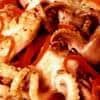 Popular in Mediterranean, Japanese, and Hawaiian cuisine, octopus is a vitamin b12 rich food. Cooked octopus provides 36μg of vitamin B-12 per 100 gram serving accounting for 600% of the DV. That is 30.6μg (510% DV) per 3 ounce serving, or 10.2μg (170% DV) per ounce. Raw octopus provides about half as much vitamin b12 with 20μg (333% DV) per 100 gram serving, 17μg (283% DV) in a 3 ounce serving, and 5.67μg (94.33% DV) per ounce. Click to see complete nutrition facts.
Popular in Mediterranean, Japanese, and Hawaiian cuisine, octopus is a vitamin b12 rich food. Cooked octopus provides 36μg of vitamin B-12 per 100 gram serving accounting for 600% of the DV. That is 30.6μg (510% DV) per 3 ounce serving, or 10.2μg (170% DV) per ounce. Raw octopus provides about half as much vitamin b12 with 20μg (333% DV) per 100 gram serving, 17μg (283% DV) in a 3 ounce serving, and 5.67μg (94.33% DV) per ounce. Click to see complete nutrition facts.
 Popular in Mediterranean, Japanese, and Hawaiian cuisine, octopus is a vitamin b12 rich food. Cooked octopus provides 36μg of vitamin B-12 per 100 gram serving accounting for 600% of the DV. That is 30.6μg (510% DV) per 3 ounce serving, or 10.2μg (170% DV) per ounce. Raw octopus provides about half as much vitamin b12 with 20μg (333% DV) per 100 gram serving, 17μg (283% DV) in a 3 ounce serving, and 5.67μg (94.33% DV) per ounce. Click to see complete nutrition facts.
Popular in Mediterranean, Japanese, and Hawaiian cuisine, octopus is a vitamin b12 rich food. Cooked octopus provides 36μg of vitamin B-12 per 100 gram serving accounting for 600% of the DV. That is 30.6μg (510% DV) per 3 ounce serving, or 10.2μg (170% DV) per ounce. Raw octopus provides about half as much vitamin b12 with 20μg (333% DV) per 100 gram serving, 17μg (283% DV) in a 3 ounce serving, and 5.67μg (94.33% DV) per ounce. Click to see complete nutrition facts.#5: Fish  Known for their omega 3 fats and for being a high protein food, fish are also a good source of vitamin B12. Mackerel provides the most vitamin B-12 with 19μg per 100g serving (317% DV), followed by Herring (312% DV), Salmon (302%), Tuna (181%), Cod (167%), Sardines (149%), Trout (130%), and Bluefish (104%).
Known for their omega 3 fats and for being a high protein food, fish are also a good source of vitamin B12. Mackerel provides the most vitamin B-12 with 19μg per 100g serving (317% DV), followed by Herring (312% DV), Salmon (302%), Tuna (181%), Cod (167%), Sardines (149%), Trout (130%), and Bluefish (104%).
Click to see complete nutrition facts. Canned Fish Highest in Vitamin B12.
 Known for their omega 3 fats and for being a high protein food, fish are also a good source of vitamin B12. Mackerel provides the most vitamin B-12 with 19μg per 100g serving (317% DV), followed by Herring (312% DV), Salmon (302%), Tuna (181%), Cod (167%), Sardines (149%), Trout (130%), and Bluefish (104%).
Known for their omega 3 fats and for being a high protein food, fish are also a good source of vitamin B12. Mackerel provides the most vitamin B-12 with 19μg per 100g serving (317% DV), followed by Herring (312% DV), Salmon (302%), Tuna (181%), Cod (167%), Sardines (149%), Trout (130%), and Bluefish (104%).Click to see complete nutrition facts. Canned Fish Highest in Vitamin B12.
#6: Crab and Lobster 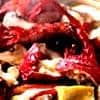 Crab and lobster are most commonly served baked, steamed, or in bisque. A 100g serving of crab contains 11.5μg of vitamin B12 (192% of the DV), that is 15.4μg (257%DV) per leg (134g). Lobster will provide 4.04μg(67% DV) per 100g serving, or 6.59μg (110% DV) in an average whole lobster (163g).
Crab and lobster are most commonly served baked, steamed, or in bisque. A 100g serving of crab contains 11.5μg of vitamin B12 (192% of the DV), that is 15.4μg (257%DV) per leg (134g). Lobster will provide 4.04μg(67% DV) per 100g serving, or 6.59μg (110% DV) in an average whole lobster (163g).
Click to see complete nutrition facts.
 Crab and lobster are most commonly served baked, steamed, or in bisque. A 100g serving of crab contains 11.5μg of vitamin B12 (192% of the DV), that is 15.4μg (257%DV) per leg (134g). Lobster will provide 4.04μg(67% DV) per 100g serving, or 6.59μg (110% DV) in an average whole lobster (163g).
Crab and lobster are most commonly served baked, steamed, or in bisque. A 100g serving of crab contains 11.5μg of vitamin B12 (192% of the DV), that is 15.4μg (257%DV) per leg (134g). Lobster will provide 4.04μg(67% DV) per 100g serving, or 6.59μg (110% DV) in an average whole lobster (163g).Click to see complete nutrition facts.
#7: Beef 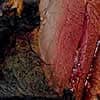 In addition to being a vitamin B12 rich food, beef is also a good source of protein, zinc, and heme-iron. The amount of vitamin B-12 in beef depends on the cut, lean fat-trimmed chuck contains the most vitamin B12 with 6.18μg (103% DV) per 100g serving, 11.49μg (103% DV) in a chuck steak, and 5.25μg (88% DV) in a 3 ounce serving. Chuck is followed by sirloin (62% DV), rib-eye (60% DV), and ribs (58% DV).
In addition to being a vitamin B12 rich food, beef is also a good source of protein, zinc, and heme-iron. The amount of vitamin B-12 in beef depends on the cut, lean fat-trimmed chuck contains the most vitamin B12 with 6.18μg (103% DV) per 100g serving, 11.49μg (103% DV) in a chuck steak, and 5.25μg (88% DV) in a 3 ounce serving. Chuck is followed by sirloin (62% DV), rib-eye (60% DV), and ribs (58% DV).
Click to see complete nutrition facts.
 In addition to being a vitamin B12 rich food, beef is also a good source of protein, zinc, and heme-iron. The amount of vitamin B-12 in beef depends on the cut, lean fat-trimmed chuck contains the most vitamin B12 with 6.18μg (103% DV) per 100g serving, 11.49μg (103% DV) in a chuck steak, and 5.25μg (88% DV) in a 3 ounce serving. Chuck is followed by sirloin (62% DV), rib-eye (60% DV), and ribs (58% DV).
In addition to being a vitamin B12 rich food, beef is also a good source of protein, zinc, and heme-iron. The amount of vitamin B-12 in beef depends on the cut, lean fat-trimmed chuck contains the most vitamin B12 with 6.18μg (103% DV) per 100g serving, 11.49μg (103% DV) in a chuck steak, and 5.25μg (88% DV) in a 3 ounce serving. Chuck is followed by sirloin (62% DV), rib-eye (60% DV), and ribs (58% DV).Click to see complete nutrition facts.
#8: Lamb (Mutton) 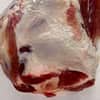 Lamb is a common meat in the Middle East, Mediterranean, East Asia, Australia, New Zealand, and most of Europe. Lamb is a high cholesterol food so be sure to look for lean cuts which are higher in B12 anyway. Lamb also provides high amounts of protein, and zinc. The shoulder is the cut of lamb with the most vitamin B-12 providing 3.71μg (62% DV) per 100g serving, 5.82μg (97% DV) per pound, and 3.15μg (53% DV) in a 3 ounce serving. The shoulder is followed by the foreshank and leg which provides 53% of the DV per 100g serving, and lamb chops which provide 51% of the DV for vitmain B12 per 100 gram serving. Click to see complete nutrition facts.
Lamb is a common meat in the Middle East, Mediterranean, East Asia, Australia, New Zealand, and most of Europe. Lamb is a high cholesterol food so be sure to look for lean cuts which are higher in B12 anyway. Lamb also provides high amounts of protein, and zinc. The shoulder is the cut of lamb with the most vitamin B-12 providing 3.71μg (62% DV) per 100g serving, 5.82μg (97% DV) per pound, and 3.15μg (53% DV) in a 3 ounce serving. The shoulder is followed by the foreshank and leg which provides 53% of the DV per 100g serving, and lamb chops which provide 51% of the DV for vitmain B12 per 100 gram serving. Click to see complete nutrition facts.
 Lamb is a common meat in the Middle East, Mediterranean, East Asia, Australia, New Zealand, and most of Europe. Lamb is a high cholesterol food so be sure to look for lean cuts which are higher in B12 anyway. Lamb also provides high amounts of protein, and zinc. The shoulder is the cut of lamb with the most vitamin B-12 providing 3.71μg (62% DV) per 100g serving, 5.82μg (97% DV) per pound, and 3.15μg (53% DV) in a 3 ounce serving. The shoulder is followed by the foreshank and leg which provides 53% of the DV per 100g serving, and lamb chops which provide 51% of the DV for vitmain B12 per 100 gram serving. Click to see complete nutrition facts.
Lamb is a common meat in the Middle East, Mediterranean, East Asia, Australia, New Zealand, and most of Europe. Lamb is a high cholesterol food so be sure to look for lean cuts which are higher in B12 anyway. Lamb also provides high amounts of protein, and zinc. The shoulder is the cut of lamb with the most vitamin B-12 providing 3.71μg (62% DV) per 100g serving, 5.82μg (97% DV) per pound, and 3.15μg (53% DV) in a 3 ounce serving. The shoulder is followed by the foreshank and leg which provides 53% of the DV per 100g serving, and lamb chops which provide 51% of the DV for vitmain B12 per 100 gram serving. Click to see complete nutrition facts.#9: Cheese 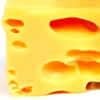 Despite being a high cholesterol food, cheese is a good source ofcalcium, protein, and Riboflavin (Vitamin B2). The amount of vitamin B12 in cheese depends on type and variety, Swiss cheese provides the most with 3.34μg (56% DV) per 100g serving, followed by Gjetost (40% DV), Mozzarella(39% DV), Parmesan (38% DV), Tilsit (35% DV), and Feta (28% DV). Click to see complete nutrition facts.
Despite being a high cholesterol food, cheese is a good source ofcalcium, protein, and Riboflavin (Vitamin B2). The amount of vitamin B12 in cheese depends on type and variety, Swiss cheese provides the most with 3.34μg (56% DV) per 100g serving, followed by Gjetost (40% DV), Mozzarella(39% DV), Parmesan (38% DV), Tilsit (35% DV), and Feta (28% DV). Click to see complete nutrition facts.
 Despite being a high cholesterol food, cheese is a good source ofcalcium, protein, and Riboflavin (Vitamin B2). The amount of vitamin B12 in cheese depends on type and variety, Swiss cheese provides the most with 3.34μg (56% DV) per 100g serving, followed by Gjetost (40% DV), Mozzarella(39% DV), Parmesan (38% DV), Tilsit (35% DV), and Feta (28% DV). Click to see complete nutrition facts.
Despite being a high cholesterol food, cheese is a good source ofcalcium, protein, and Riboflavin (Vitamin B2). The amount of vitamin B12 in cheese depends on type and variety, Swiss cheese provides the most with 3.34μg (56% DV) per 100g serving, followed by Gjetost (40% DV), Mozzarella(39% DV), Parmesan (38% DV), Tilsit (35% DV), and Feta (28% DV). Click to see complete nutrition facts.#10: Eggs 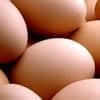
When it comes to chicken eggs the raw yellow has most of the vitamin B-12 with 1.95μg per 100g serving (33%), however, this equates to 0.33μg per yolk or just 6% of the DV. The eggs of other animals are higher with a goose egg providing 7.34μg (122% DV) of vitamin B-12 per 100g serving, and a duck egg providing 3.78μg (63% DV). 
| Fortified Cereals* List of Cereals High in Vitamin B12 | 20μg (333% DV) per 100 gram serving | 16μg (267% DV) in an average bowl (2 cups) (80 grams) | 8μg (133% DV) per cup (40 grams) | Click to see complete nutrition facts for Fortified Cereals |
| Liverwurst Sausage | 13.46μg (224% DV) per 100 gram serving | 2.42μg (40% DV) per slice (18 grams) | 3.77μg (63% DV) per ounce (28 grams) | Click to see complete nutrition facts for Liverwurst Sausage |
| Fortified Energy Bars* | 12.24μg (204% DV) per 100 gram serving | 5.39μg (90% DV) per bar (44 grams) | 2.7μg (45% DV) in half a bar (22 grams) | Click to see complete nutrition facts for Fortified Energy Bars |
| Fois Gras (Goose Liver Pâté) | 9.4μg (157% DV) per 100 gram serving | 1.22μg (20% DV) per tablespoon (13 grams) | 2.63μg (44% DV) per ounce (28 grams) | Click to see complete nutrition facts for Fois Gras (Goose Liver Pâté) |
| Emu Steak | 9.37μg (156% DV) per 100 gram serving | 36.92μg (615% DV) per tablespoon (394 grams) | 7.96μg (133% DV) per ounce (85 grams) | Click to see complete nutrition facts for Emu Steak |
| New England Clam Chowder | 4.8μg (80% DV) per 100 gram serving | 12.1μg (202% DV) per cup (252 grams) | 1.54μg (26% DV) in a fluid ounce (32 grams) | Click to see complete nutrition facts for New England Clam Chowder |
| Manhattan Clam Chowder | 3.3μg (55% DV) per 100 gram serving | 7.92μg (132% DV) per cup (240 grams) | 0.99μg (17% DV) in a fluid ounce (30 grams) | Click to see complete nutrition facts for Manhattan Clam Chowder |
| Luncheon Meat* | 5.14μg (86% DV) per 100 gram serving | 1.44μg (24% DV) per one ounce slice (28 grams) | 2.88μg (48% DV) in two slices (56 grams) | Click to see complete nutrition facts for Luncheon Meat |
| Hard Salami* | 2.8μg (47% DV) per 100 gram serving | 3.16μg (53% DV) in one 4 ounce package (113 grams) | 0.28μg (5% DV) per slice (10 grams) | Click to see complete nutrition facts for Hard Salami |
| Whey Powder | 2.37μg (40% DV) per 100 gram serving | 3.44μg (57% DV) per cup (145 grams) | 0.19μg (3% DV) per tablespoon (8 grams) | Click to see complete nutrition facts for Dry Sweet Whey |
| Yogurt (No Fat) | 0.61μg (10% DV) per 100 gram serving | 1.49μg (25% DV) per cup (8oz) (245 grams) | 0.69μg (12% DV) per 4oz serving (half-container) (113 grams) | Click to see complete nutrition facts for Plain Yogurt (No Fat) |
| Yogurt (Whole) | 0.37μg (6% DV) per 100 gram serving | 0.91μg (15% DV) per cup (8oz) (245 grams) | 0.42μg (7% DV) per 4oz serving (half-container) (113 grams) | Click to see complete nutrition facts for Plain Yogurt (Whole) |
| Skim Milk | 0.53μg (9% DV) per 100 gram serving | 1.3μg (22% DV) per cup (245 grams) | 0.16μg (3% DV) in a fluid ounce (31 grams) | Click to see complete nutrition facts for Non-Fat Milk |
| Whole Milk | 0.44μg (7% DV) per 100 gram serving | 1.07μg (18% DV) per cup (244 grams) | 0.14μg (2% DV) in a fluid ounce (31 grams) | Click to see complete nutrition facts for Full Fat Milk |
| Low-Fat Buttermilk | 0.22μg (4% DV) per 100 gram serving | 0.54μg (9% DV) per cup (245 grams) | 0.07μg (1% DV) in a fluid ounce (31 grams) | Click to see complete nutrition facts for Low-fat Buttermilk |
| Yeast Extract Spread (Marmite) | 0.5μg (8% DV) per 100 gram serving | 1.44μg (48% DV) per cup (288 grams) | 0.03μg (1% DV) per teaspoon (6 grams) | Click to see complete nutrition facts for Yeast Extract Spread |
| Cured Ham (Lean) | 0.65μg (11% DV) per 100 gram serving | 0.91μg (15% DV) per cup (140 grams) | 0.55μg (9% DV) in a 3 ounce serving (85 grams) | Click to see complete nutrition facts for Extra Lean Cured Ham |
| Chicken (Lean) | 0.31μg (5% DV) per 100 gram serving | 0.43μg (7% DV) per cup chopped (140 grams) | 0.21μg (3% DV) in a half-cup (70 grams) | Click to see complete nutrition facts for Lean Roasted Chicken |
| Fortified Soymilk* | 1.11μg (19% DV) per 100 gram serving | 2.7μg (45% DV) per cup (243 grams) | 0.3μg (5% DV) per ounce (28 grams) | Click to see complete nutrition facts for Fortified Soymilk |
| Fortified Tofu* | 2.36μg (39% DV) per 100 gram serving | 1.86μg (31% DV) per serving (1/4 packet) (79 grams) | 0.7μg (11% DV) per ounce (28 grams) | Click to see complete nutrition facts for Fortified Tofu |
 for your bags, sleep on two pillows, and on your side or back, not your belly.
for your bags, sleep on two pillows, and on your side or back, not your belly.You can also try depuffing eye gels, from Nivea, Origins, Oil of Olay, Clinique.
For the dark circles, use a concealer that is slighter lighter then your natural skin tone, that has a yellowish base (to cancel out the grey and blue of the circles.) Apply it with your ring finger, which has a the lightest touch. Pat it on.
Good concealers:
Physicians’ Formula, Maybelline, MAC, Clinique, Cover Girl, L’oreal.
Physicians’ Formula, Maybelline, MAC, Clinique, Cover Girl, L’oreal.
Set with powder.
If you want more colour in your skin without a makeup feel, try rubbing in a cream blush that is baby pink or peach. Try:
Smashbox O-Glow, a clear cream that you put on your cheeks, and then it turns into a blush that matches your skintone.
Also, Benefit Benetint.
Vincent Longo stains.here are new lotions out on the market that have some type of bronzers in them and as you use them they gradual add color. I know lots of the higher cost brands now sell them. I do know that makeup is sometimes a bummer but I have heard really really good things about the bare minerals being very light and undetectable by the wearer. Hope this helps some. Oh they also have some tanning face beds that can also help with this if your not worried about UVB and UVA.If you’d like to make your smile whiter without getting it done
Also, Benefit Benetint.
Vincent Longo stains.here are new lotions out on the market that have some type of bronzers in them and as you use them they gradual add color. I know lots of the higher cost brands now sell them. I do know that makeup is sometimes a bummer but I have heard really really good things about the bare minerals being very light and undetectable by the wearer. Hope this helps some. Oh they also have some tanning face beds that can also help with this if your not worried about UVB and UVA.If you’d like to make your smile whiter without getting it done
professionally….
First off just brush your teeth daily, but when brushing be sure to use baking soda! Do it once or twice daily.
You can also use colgate whitening tooth paste that helps a lot!
You can also use colgate whitening tooth paste that helps a lot!
Health Benefits of Vitamin B12
- Protect Against Heart Disease - Adequate levels of vitamins B12, B6, and B9have been shown to lower levels of a protein in the blood: homocysteine. Lower levels of homocysteine has been shown to improve endothelial function, which in turn may boost cardiovascular health and decrease risk of heart attacks.3-5
- Protect and Repair DNA to Reduce Cancer Risk and Slow Aging - Absorption of vitamin b12 and Folate (B9) is essential for DNA metabolism and maintenance which helps to prevent cancer and slow aging.6 Read full blog post here...
- Protect Against Dementia and Cognitive Decline - Lack of vitamin B12 increases homocysteine levels, which in turn decreases the bodies ability to metabolize neurotransmitters.7 Due to limitations with creating long term controlled studies in human populations, no definite link between increased vitamin b12 levels and cognitive function have been found,8-12 however several observational studies suggest increased homocysteine levels increase the incidence of Alzheimer's disease and dementia,13-15 and low levels of vitamin B12 has been associated with cognitive decline.16
- Alzheimer's Protection - A study has shown that a deficiency in Vitamin B12 and Folate (B9) can double the risk of Alzheimer's Disease.17
- Energy and Endurance - A lack of vitamin B12 will lead to anemia and weakness. Adequate levels of vitamin B12 are necessary to maintain normal energy levels. Claims of vitamin B12 as an energy or atheletic enhancer remain unproven.18
People at Risk of a Vitamin B12 Deficiency
- Older Adults who have Atrophic Gastritis - A condition affecting 30-50% of adults over age 50 and hampers their ability to absorb vitamin B12 from natural foods. Supplements are recommended for people in this group.
- People with Pernicious Anemia - A condition that affects 1-2% of adults and can only effectively be treated with vitamin B12 injections or shots.
- Vegans and Vegetarians - Vitamin B12 is naturally found in animal products, however there are some natural vegetarian foods high in vitamin b12 and various fortified B12 foods for vegans.
- Pregnant and Lactating Women who are Vegetarian or Vegan
- People taking Certain Medications
- Proton pump inhibitors, such as omeprazole (Prilosec®) and lansoprazole (Prevacid®), which are used to treat gastric or pepetic ulcer disease can inhibit absorption of vitamin B12.
- Metformin - often used for type II diabetes, may interfere with vitmain B12 absorption in certain people.
- Histamine antagonists, such as cimetidine (Tagamet®), famotidine (Pepcid®), and ranitidine (Zantac®), used to treat peptic ulcer disease, can reduce absorption of vitmain B12 by slowing the release of hydrochloric acid into the stomach.
- Bacteriostatic Antibiotics, like Chloramphenicol (Chloromycetin®), can interfere with the red blood cell response to vitamin b12 supplements.
- Anticonvulsants - Anticonvulsants have been shown to interfere with vitamin B12 and vitamin B9 (Folate) metabolism.19-21 One study found that people taking folate supplements and anticonvulsants experienced a 50% decline in Vitamin B12 blood levelsWhat Does Vitamin B12 Do in Your Body?
- Helps to form myelin, which is a fatty cover that insulates your nerves.
- Helps to produce energy from metabolism of fat and protein.
- Helps to produce hemoglobin, which is the component of your red blood cells that carrys oxygen to your cells. This is why a vitamin B12 deficiency can cause fatigue.
- Reduces your homocysteine level, which lowers your risk of stroke, heart disease, cancer, Parkinson's, Alzheimer's disease, and many degenerative diseases.
- Regulates growth, maintenance, and reproduction of all of your cells
Here are some healthy, whole food sources of vitamin B12:Whole Food Sources Serving Vitamin B12 (mcg) Beef Liver, cooked 3 ounces 68 Wild Salmon, baked 3 ounces 2.4 Grass-fed beef, cooked 3 ounces 2.0 Raw cow's milk 8 ounces 0.9 Organic cheese 1 ounce 0.5 Organic egg, hard boiled 1 large 0.4 Organic chicken, cooked 3 ounces 0.3 Organic turkey, cooked 3 ounces 0.3 Signs of Deficiency- Chronic fatigue - macrocytic / megaloblastic anemia
- Unexplained numbness or tingling of arms or legs
- Anxiety and irritability
- Depression
- Digestive problems like a sore tongue, loss of appetite, and constipation
- Poor hair
Normally, B12 must be broken apart from food by acid and enzymes in the stomach. B12 must then be tied together with a protein called intrinsic factor, which is produced by cells that line your stomach. Intrinsic factor carries B12 across your intestinal wall into your blood, to be delivered to your cells. This journey across your intestinal wall requires the presence of calcium, which is suppled by your pancreas.Pernicious anemia is a condition that involves gradual destruction of cells that line your stomach, which decreases the ability to break B12 apart from food and decreases the availability of intrinsic factor to carry B12 into the blood.If you are deficient in B12 because you don't have enough stomach acid, enzymes, and/or intrinsic factor, you might have to receive injections of B12 directly into your blood via your muscles.Another option is to take high oral doses of vitamin B12, which can lead to a small percent being absorbed into your bloodstream without the help of intrinsic factor. An oral dose of 1000 mcg results in approximately 10 mcg entering your bloodstream.
No comments:
Post a Comment